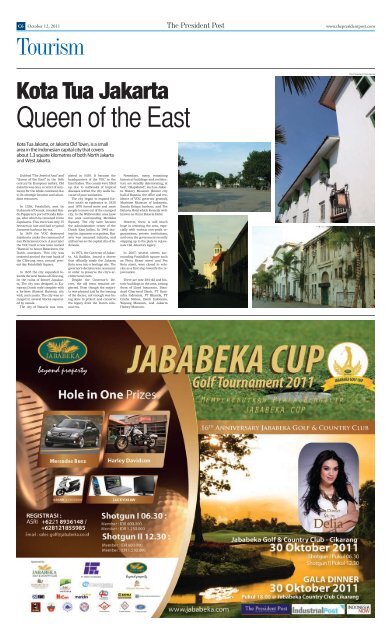28th Edition - The President Post
28th Edition - The President Post
28th Edition - The President Post
Create successful ePaper yourself
Turn your PDF publications into a flip-book with our unique Google optimized e-Paper software.
C6<br />
October 12, 2011<br />
<strong>The</strong> <strong>President</strong> <strong>Post</strong><br />
www.thepresidentpost.com<br />
Tourism<br />
<strong>The</strong> <strong>President</strong> <strong>Post</strong>/Akmal<br />
Kota Tua Jakarta<br />
Queen of the East<br />
Kota Tua Jakarta, or Jakarta Old Town, is a small<br />
area in the Indonesian capital city that covers<br />
about 1.3 square kilometres of both North Jakarta<br />
and West Jakarta.<br />
Dubbed “<strong>The</strong> Jewel of Asia” and<br />
“Queen of the East” in the 16th<br />
century by European sailors, Old<br />
Jakarta was once a center of commerce<br />
for the whole continent due<br />
to its strategic location and abundant<br />
resources.<br />
In 1526, Fatahillah, sent by<br />
Sultanate of Demak, invaded Hindu<br />
Pajajaran’s port of Sunda Kelapa,<br />
after which he renamed it into<br />
Jayakarta. This town was only 15<br />
hectares in size and had a typical<br />
Javanese harbour lay-out.<br />
In 1619 the VOC destroyed<br />
Jayakarta under the command of<br />
Jan Pieterszoon Coen. A year later<br />
the VOC built a new town named<br />
“Batavia” to honor Batavieren, the<br />
Dutch ancestors. This city was<br />
centered around the east bank of<br />
the Ciliwung river, around present<br />
day Fatahillah Square.<br />
In 1635 the city expanded towards<br />
the west banks of Ciliwung,<br />
on the ruins of former Jayakarta.<br />
<strong>The</strong> city was designed in European<br />
Dutch style complete with<br />
a fortress (Kasteel Batavia), city<br />
wall, and canals. <strong>The</strong> city was arranged<br />
in several blocks separated<br />
by canals.<br />
<strong>The</strong> city of Batavia was completed<br />
in 1650. It became the<br />
headquarters of the VOC in the<br />
East Indies. <strong>The</strong> canals were filled<br />
up due to outbreaks of tropical<br />
diseases within the city walls because<br />
of poor sanitation.<br />
<strong>The</strong> city began to expand further<br />
south as epidemics in 1835<br />
and 1870 forced more and more<br />
people to move out of the cramped<br />
city, to the Weltevreden area (now<br />
the area surrounding Merdeka<br />
Square). <strong>The</strong> city later became<br />
the administrative center of the<br />
Dutch East Indies. In 1942 during<br />
the Japanese occupation, Batavia<br />
was renamed Jakarta, and<br />
still serves as the capital city of Indonesia.<br />
In 1972, the Governor of Jakarta,<br />
Ali Sadikin, issued a decree<br />
that officially made the Jakarta<br />
Kota area into a heritage site. <strong>The</strong><br />
governor’s decision was necessary<br />
in order to preserve the city’s architectural<br />
roots.<br />
Despite the Governor’s Decree,<br />
the old town remains neglected.<br />
Even though the majority<br />
was pleased just by the issuing<br />
of the decree, not enough was being<br />
done to protect and conserve<br />
the legacy from the Dutch colonial<br />
era.<br />
Nowadays, many remaining<br />
historical buildings and architecture<br />
are steadily deteriorating; at<br />
best, “dilapidated”, such as Jakarta<br />
History Museum (former city<br />
hall of Batavia, the office and residence<br />
of VOC governor general),<br />
Maritime Museum of Indonesia,<br />
Sunda Kelapa harbour, and <strong>The</strong><br />
Batavia Hotel which formerly wellknown<br />
as Omni Batavia Hotel.<br />
However, there is still much<br />
hope in restoring the area, especially<br />
with various non-profit organizations,<br />
private institutions,<br />
and even the government recently<br />
stepping up to the plate to rejuvenate<br />
Old Jakarta’s legacy.<br />
In 2007, several streets surrounding<br />
Fatahillah square such<br />
as Pintu Besar street and Pos<br />
Kota street, were closed to vehicles<br />
as a first step towards the rejuvenation.<br />
<strong>The</strong>re are now 284 old and historic<br />
buildings in the area, among<br />
them of Lloyd Insurance, Standard<br />
Chartered Bank, PT Samudra<br />
Indonesia, PT Bhanda, PT<br />
Graha Raksa, Bank Indonesia,<br />
Wayang Museum, and Jakarta<br />
History Museum.








